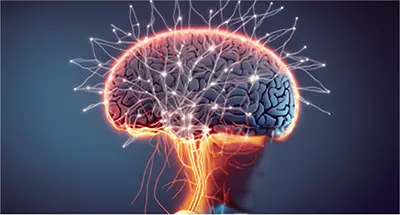Brain and Mind Technology

Neuroscience
Neuroscience is a multidisciplinary field that seeks to understand the structure and function of the nervous system. It encompasses a wide range of approaches, including molecular and cellular biology, anatomy, physiology, psychology, and computational modeling. By studying the brain and nervous system, neuroscientists aim to shed light on how we perceive the world, make decisions, learn and remember, and experience emotions.
One of the most significant breakthroughs in neuroscience in recent years has been the development of optogenetics, a technique that allows researchers to control the activity of specific neurons in the brain using light. By inserting light-sensitive proteins into neurons, researchers can use a laser to activate or inhibit the neurons, allowing them to study how different parts of the brain contribute to behavior, cognition, and disease. Optogenetics has already led to a deeper understanding of the neural basis of movement, addiction, and depression.
Another exciting area of neuroscience research is the study of the brain's connectome, or the complete network of connections between neurons in the brain. Advances in imaging technology have made it possible to map the connectome with unprecedented detail, providing insights into how different brain regions communicate and how information is processed. Mapping the connectome may also help us understand how changes in the brain's wiring contribute to neurological and psychiatric disorders such as Alzheimer's disease and schizophrenia.
Neuroscience research is also shedding light on the relationship between the brain and behavior. For example, recent studies have shown that the gut microbiome, the collection of microorganisms that live in our digestive tracts, can influence brain function and behavior. Researchers are exploring the potential of manipulating the microbiome to treat neurological and psychiatric disorders such as anxiety and depression.
Looking to the future, there is hope that neuroscience research will lead to new treatments for a wide range of neurological and psychiatric disorders. One promising avenue of research is the development of brain-computer interfaces (BCIs), which allow individuals with paralysis or other motor disorders to control external devices such as prosthetic limbs using their thoughts. BCIs could also be used to treat conditions such as chronic pain or depression by stimulating specific regions of the brain.
Future breakthroughs in neuroscience could have a great effect on society. What will the world be like when technology can tell us without a doubt that the accused is guilty of a crime, a spouse has cheated, or an employee would likely steal? How about uploading your memories for posterity or downloading the skills you need for that new job? Record your dreams for later viewing or control your computer (or any device), just by thinking about it. Many of these futuristic technologies are already in development.
Researchers are studying ways to improve memory, learning and other mental abilities by using substances called cognitive enhancers or smart drugs. Some experts predict that by the year 2050, computers will have the capacity to store all of the information contained in the human brain. For those that can afford immortality, their brains could be scanned and downloaded to machines, perhaps to be uploaded to a new brain.
Overall, neuroscience research has the potential to transform our understanding of the brain and how it influences our behavior and experiences. By advancing our knowledge of the nervous system, we can develop new therapies and interventions to improve the lives of individuals with neurological and psychiatric disorders.
Here as some general facts about the brain:
Center of the human nervous system
Most complex organ on earth
Weighs on average about 3 lb (1.5 kg)
Consistency similar to jelly
Estimated 50–100 billion neurons
Brain Machine Interface

Brain machine interfaces (BMIs), allow for activity in the brain to be sent to, or received from, a computer.
Some BMIs use sensors mounted in a removable cap or MRI technology to read signals from the brain. Others connect directly to the surface of the brain, through tiny wires and an array of micro-electrodes. BMIs can also be entirely implanted in the brain.
Lie Detection

Powerful lie detection tools may someday surpass the accuracy of the polygraph and permanently change how suspects are convicted -- and freed.
Imagine, a suspect is read words related to a crime while their brain is being scanned. A computer analyzes the data and informs the examiner if the suspect's memory holds information about the crime that only the perpetrator could know. The guilty could be clearly identified and the innocent would be set free.
Brain Technology Articles and Web Sites
I search the internet daily for new articles from around the world that interest me or I think will interest you. My hope is that it saves you time or helps students with their assignments. Listed by most recent first, dating back to 2005.
-
A long-lasting neural probe from Harvard College
-
Brainoware: Pioneering AI and Brain Organoid Fusion from Electropages
-
Rice scientists use blood test to track gene expression in the brain from Rice University
-
MindPortal human-AI telepathy website
-
A breakthrough for brain imaging from University of California
-
The Implications of AI Recreating Images From Our Mind is Frightening from PetaPixel
-
Immersive VR goggles for mice unlock new potential for brain science from Northwestern Now
-
Scientists probe into a rat’s inner thoughts, find imagination from Interesting Engineering
-
We built a nanotechnology ‘brain’ from tiny silver wires from Cosmos
-
In a first, memory shown to have two distinct past and future paths from New Atlas
-
Newly Discovered Spirals of Brain Activity May Help Explain Cognition from Singularity Hub
-
Scientists Unveil Unprecedented Live View Into the Brain’s Complexity from SciTechDaily
-
Pioneering research: Non-invasive brain stimulation with superior accuracy from EurekAlert
-
Scientists Just Unveiled the Most Complete Map of the Monkey Cortex Yet from Singularity Hub
-
Scientists Unveil New Results in Hunt to Pinpoint the Seat of Consciousness from Singularity Hub
-
Emerging ethical issues in research on consciousness from Human Brain Project
-
Can the Human Brain Regenerate Itself? The Mystery of Brain Regeneration from SciTechDaily
-
Tuning brain cells with light from EurekAlert
-
This Brain Activity Decoder Translates Ideas Into Text Using Only Brain Scans from Singularity Hub
-
Brain Images Just Got 64 Million Times Sharper from Duke University
-
This Researcher Knew What Song People Were Listening to Based on Their Brain Activity from Singularity Hub
-
Scientists Discover How To Generate New Neurons in the Adult Brain from SciTechDaily
-
Could gene-editing be used to treat mental illness? from Thred
-
A Drug That Cures Autism? Neuroscience Study Yields Promising Results from SciTechDaily
-
Human Mini-Brains Grafted Into Injured Rats Restored Their Sight from Singularity Hub
-
How might telepathy actually work outside the realm of sci-fi? from Aeon Essays
-
MIT scientists create sensor that detects light deep inside the brain from Brain Tomorrow
-
This neuroscientist’s breakthrough experiment could herald a new era of psychiatry from Inverse
-
What Constitutes a Mind? from Singularity Hub
-
We’ve Got News for You About Supercharging Your Brain from Nautilus
-
New research suggests our brains use quantum computation from Phys.org
-
A dish full of brain cells has learned to play the computer game Pong from NPR
-
Brain-zapping tech improves memory by more than 50% from Freethink
-
A $500 Million International Project Will Create the Most Detailed Map of the Brain Ever from Singularity Hub
-
How does the brain store memories? from Live Science
-
Scientists Have Long Dreamed of a Memory Prosthesis. The First Human Trials Look Promising from Singularity Hub
-
Meta can (kinda) guess what you’ve heard via your brain waves from Freethink
-
MIT Researchers Create Artificial Synapses 10,000x Faster Than Biological Ones from Singularity Hub
-
Could We Really Increase Human IQ via Genetic Engineering? from Mind Matters

